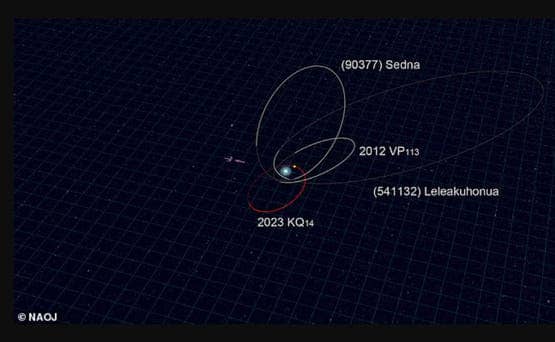Rare 'Cosmic Fossil' Discovered at the Edges of the Solar System Rethinks the 'Ninth Planet' Hypothesis

A team of astronomers has spotted a rare icy body in the distant regions of the solar system, naming it 'Ammonite,' in a discovery that may shed light on the early stages of the formation of our solar system.
The object, scientifically named 2023 KQ14, was observed using the Subaru Telescope in Hawaii, located at a distance estimated to be 71 times the distance between Earth and the Sun, in a region beyond the planet Pluto. This body belongs to a rare class known as 'Centaurs,' which are icy bodies resembling those found in the Kuiper Belt or dwarf planets like Pluto.
'Ammonite' is considered an exceptional astronomical body, as only four similar bodies have been known in the solar system so far. This object is distinguished by a unique orbit that remained stable for about 4.5 billion years, leading scientists to describe it as a 'cosmic fossil' bearing vital clues to the history of the solar system. However, orbit analyses revealed a mysterious change in its trajectory over time, indicating that the remote regions of the solar system are more complex than previously thought.
This discovery has significant implications for the 'Ninth Planet' hypothesis, the hypothetical celestial body believed to be lurking in the depths of the solar system. Researchers noted that the orbit of 'Ammonite' does not align with the theoretical expectations for the location of this planet, reducing the likelihood of its existence. Previous studies had identified only one body out of 13 candidate objects that could be the Ninth Planet, making the discovery of 'Ammonite' a new factor in this complex astronomical equation.
This discovery was part of the 'Fossil' project (FOSSIL), which aims to study rare icy bodies that hold secrets about the formation of the solar system. Instead of focusing on the search for the 'Ninth Planet,' as in previous years, scientists are now turning to analyze these 'ice fossils' to understand the early evolution of the distant regions of our solar system.
It is worth noting that the 'Ninth Planet' hypothesis has been a subject of debate for decades, with the belief that it is a mysterious planet orbiting the sun at a distance ranging from 46.5 billion to 65.1 billion miles. However, with discoveries like 'Ammonite,' it seems that answers may come from studying the distant past of the solar system, rather than searching for hypothetical planets.